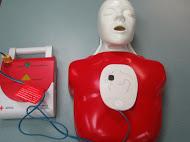
Automated electronic defibrillators are useful first aid gadgets. As the name implies, these health care supplies use automated working mechanisms. They are advancements from earlier manual defibrillators. The primary role of an AED is to prevent a patient from going into cardiac arrest. Some advanced models come with air bags to help patients who are suffering from airway problems. In order to use these tools, you need to take first aid training for advanced life support. There are many institutions that teach people how to use AEDs. Although the models available in the market differ slightly in design, all of them operate using a similar process. Here is what you need to know about using an AED.
Determine Whether to Use the AED
With manual defibrillators, the first aider must observe the accident victim to determine whether to use the device or not. The first aid attendant must monitor and record the patient’s vital signs such as breathing and pulse manually. If the patient is having difficulty breathing, the medical attendant on site must begin with a 2-minute CPR session. Defibrillation starts as soon as the patient stops breathing and has no pulse.
The good thing about using an automated electronic defibrillator is that it takes away the need for manual monitoring. These smart devices record a patient’s vital signs like heart rhythm and breathing patterns. Modern AEDs come with acoustic and visual signals that give instructions on whether defibrillation is necessary or not.
Steps to Use an AED
Before using the automated electronic defibrillator, make sure that it is fully charged and working properly. In addition, verify that the patient is no longer breathing and has no heartbeat. Often, the AED will advice you on whether to start defibrillation or not.
To begin defibrillation, remove the patient’s top clothing and leave the chest bear. Make sure to place the two electrodes on the right positions. The first one should be place just above the sternum, below the clavicle. The other electrode rests on the ribs to the left of nipple, within the center in the midaxillary line. If you are in doubt, check illustration diagrams on how to place AED electrodes.
Once everything is in place, turn on the power. Make sure that there is no water or fluids around the patient as this can transfer electric shock to other personnel near the accident scene. If the AED instructs you to administer a shock, shout ‘all clear’ to alert other people near the scene to clear, and then deliver the shock. If the patient starts breathing, stay put until emergency help arrives. Provide rescue breaths if there is inadequate breathing and begin CPR if the patient is unresponsive. Always avoid touching the patient when delivering a shock to avoid electrocuting yourself.
